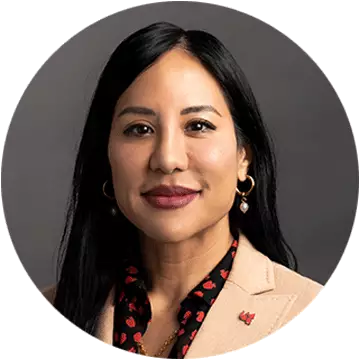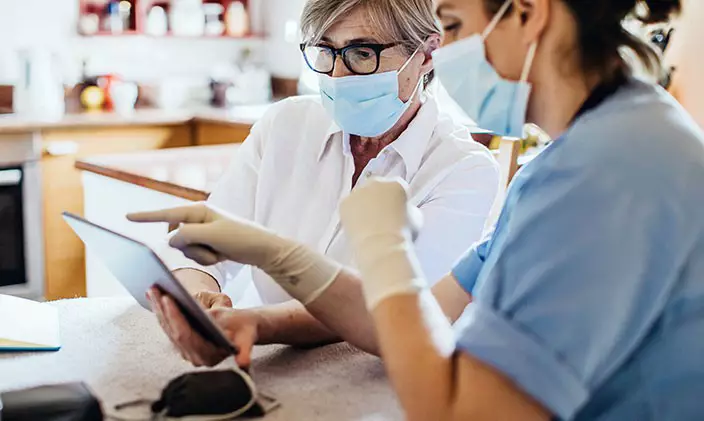What is evidence-based practice in nursing and healthcare?

Written by Michael Feder

This article was reviewed by Raelene Brooks, Dean, College of Nursing.

Evidence-based practice (EBP) uses current research to inform care-related decisions. The goal of EBP is to improve patients' overall care and safety while minimizing the costs and variations in health outcomes.
EBP has three main components. It seeks the best outcomes by using the best available external evidence, drawing on caregivers' clinical expertise, and considering input and expectations from patients. The result of this strategy is a holistic treatment plan that combines the patient's wishes with the expertise of healthcare providers.
If you take part in a Bachelor of Science in Nursing program or continue to a Master of Science in Nursing degree
, you will study the framework needed to use EBP in your clinical career. In fact, since evidence-based practice is essential in modern medicine, you will learn it regardless of your choice of nursing degree and even if you opt for another healthcare degree program
.
Here is a closer look at how evidence-based practice informs clinical care decisions.
Levels of evidence
Evidence-based decision-making plays a pivotal role in evidence-based practice. However, not all studies produce the same level of evidence. Some take extra steps to test and prove theories. This thorough approach makes such research more reliable.
Four primary levels of evidence are generated from research. These rankings play a role in which evidence providers choose to use when making clinical decisions.
The four EBP levels are:
- Level A is the most reliable class of evidence. Level A studies use randomized control trials. That means randomly selected groups participate in controlled experiments or tests to determine the effectiveness of a treatment or approach. This level also requires systematic reviews and analysis of relevant trials and clinical practice guidelines based on the results of the studies. Practices and treatments that stand up to this level of scrutiny are considered highly reliable.
- Level B is the second-most-reliable ranking. Studies in this level contain evidence from well-designed control trials without randomization; clinical studies; case-controlled studies; uncontrolled studies; and qualitative and quantitative studies on healthcare best practices. The studies in this level are well organized, but they do not have to pass the same level of rigorous validation as Level A research. Issues such as intentional or unintentional bias can affect the results of Level B studies.
- Level C is the least-reliable class of evidence. The evidence from this ranking comes from consensus among medical professionals and expert opinions. Typically, this level of evidence is used only when no quality data is available about a specific condition or situation.
Level ML (multilevel) is the fourth EBP evidence class. As the name suggests, it contains evidence acquired from more than one of the other levels. Level ML is often applied to complex cases with no clear connection to a specific study.
Why is evidence-based practice important?
The knowledge of EBP is essential to nurses and other healthcare professionals because it leads to informed decisions about care. However, the benefits go beyond creating the best chance for a positive outcome.
Here are some of the key advantages of adopting EBP:
- EBP helps improve patient-care outcomes by using the most-current medical strategies and research-proven techniques.
- EBP advances knowledge in healthcare by combining high-quality research and clinical experience. It encourages healthcare providers to develop and use clinical skills
in combination with evidence-based treatments.
- EBP prioritizes the needs of patients by considering their input and desires in the final treatment decisions.
- EBP can help save time and resources by using proven strategies and treatments. Because it streamlines the approach and gives healthcare providers resources and information to guide difficult decisions, evidence-based practice can also help with nursing burnout
, which is common among healthcare staff.
Evidence-based practice complements the Triple Aim framework. Triple Aim seeks to improve public health and patient experience while reducing overall healthcare costs. Because evidence-based practice can also help reduce costs and improve the patient experience by streamlining treatment, it achieves similar goals to the Triple Aim approach.
Evidence-based practice examples
Evidence-based practice can be adopted in a variety of healthcare situations. The benefits of this approach are evident in clinical settings. Here are some examples.
- Infection control: By adhering to evidence-based, infection-control guidelines, such as keeping surfaces disinfected and wearing personal protective equipment, nurses and other healthcare professionals can prevent the spread of illnesses and protect themselves from becoming infected.
- Administering oxygen: Giving patients oxygen without following the proper process and techniques may lead to hypoxia. These dangers are especially pronounced for patients with asthma or chronic obstructive pulmonary disease, but ensuring proper processes can protect patients with lung issues from serious complications.
- Administering blood transfusions: Healthcare providers can also use EBP by relying on the most suitable equipment during procedures. For example, research shows intravenous catheters for packed red blood cell transfusions reduce the risk of infection. They’re also much more comfortable for patients and efficient.
- Reducing alarm fatigue: Research has proved that specific practices for attaching health and blood pressure monitors can reduce the number of false alarms that providers need to respond to in a hospital. Alarm fatigue occurs when there are too many false or unnecessary alarms, which can lead to a slower response when there’s a life-threatening issue.
In a clinical setting, EBP requires specific steps meant to help healthcare providers arrive at the best decisions.
Steps of evidence-based practice
Evidence-based practice in healthcare fits with the lifelong learning mindset necessary to continue growing as a medical professional. Regardless of the setting or your level of expertise, EBP practitioners use the same steps to arrive at the best medical decision.
Ask a question
The evidence-based practice process begins by asking questions about the patient and their health issues. As a healthcare provider, you have to formulate answerable clinical questions regarding the patient's care. Clinical questions can be about therapy or treatment, diagnosis or prognosis, or cost of care.
These questions are the starting point that will direct your search for evidence to help with your clinical decisions.
Look for evidence
The next step involves researching to determine the highest-quality evidence that can provide answers to your questions. You can start with a broad search and focus on quality sources, such as respected medical journals and publications that normally only accept high-quality studies. You can work backward from the most recent studies to earlier research on the subject.
Analyze the evidence
The third step involves analyzing the evidence to determine its relevance, quality, validity, potential impact and applicability to your specific case. In this step, you will look for studies that offer the highest level of proof. Level A evidence, which is supported by fully randomized tests, is the best type of evidence. However, you need to ensure the studies are relevant to your particular questions. If not, you may have to move to Levels B, C or ML.
The goal of this step is to find the highest-quality evidence available for your specific questions.
Integrate your finding
This step involves incorporating the clinical study findings into your treatment plans for the patient. In this step, nurses and other medical practitioners treating the patient have to consider the evidence and new information obtained from the studies alongside established best practices and their own clinical experience.
During this step, you also need to consider the patient's wishes. EBP requires you to balance these different factors and arrive at treatment or diagnostic decisions.
Evaluate the outcome
The EBP process doesn’t stop when you start treatment. In the short term, you need to monitor the patient to see whether your approach is leading to the expected results or whether you need to consider other methods.
You also need to assess the results of your evidence-based decisions and measure how the new practices worked in your specific case. If the treatment was successful, you and your peers can consider using a similar approach in future cases.
Share the information
One advantage of evidence-based practice is that the results of your decisions can help other healthcare professionals decide what to do (or not do) in similar situations. Therefore, sharing the outcomes of evidence-based practice, whether positive or negative, with other healthcare professionals is the final step in the EBP process.
Sharing also enables other professionals to offer insights and critiques from a neutral perspective. This combined clinical knowledge can improve the overall level of healthcare that patients receive in the future.

ABOUT THE AUTHOR
A graduate of Johns Hopkins University and its Writing Seminars program and winner of the Stephen A. Dixon Literary Prize, Michael Feder brings an eye for detail and a passion for research to every article he writes. His academic and professional background includes experience in marketing, content development, script writing and SEO. Today, he works as a multimedia specialist at University of Phoenix where he covers a variety of topics ranging from healthcare to IT.

ABOUT THE REVIEWER
Dr. Raelene Brooks, dean of the College of Nursing, has been a registered nurse for more than 25 years and practiced extensively in the areas of ICU, trauma and critical care. Her publications include a focus on nursing education, critical care and diversity, equity and inclusion. She is a leader in creating, guiding and launching innovative curriculum.
This article has been vetted by University of Phoenix's editorial advisory committee.
Read more about our editorial process.
Read more articles like this:


